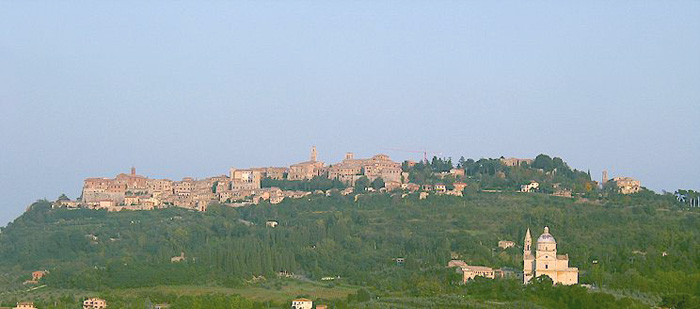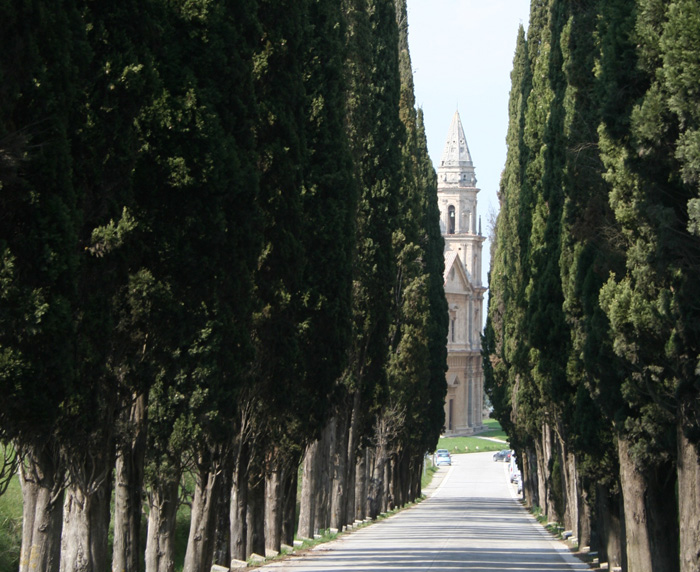| |
|
Montepulciano is in a near-idyllic location in the heart of the Tuscan countryside, between Pienza and Chiusi, and within an hour. It is built on a ridge of Monte Poliziano. According to ancient legend Montepulciano was supposedly founded according to the will of the Etruscan king, Lars Porsenna, who is said to have left Chiusi to settle on the hill of Mons Mercurius, with the other inhabitants of Chiusi who later changed the name to Mont Politicus.
The town centre ramparts encircle the historic heart of the town. The Renaissance-style palaces (Avignonesi, Communal, etc.) draw the eye along the streets surrounding the charming main square Piazza Grande. The Corso, a long, winding street climbs up into the main square, which crowns the summit of the hill. The cathedral was built in 1619. The façades of the church of Saint Agostino and of the Oratorio della Misericordia are worth seeing. Notable among the civic buildings are the Tarugi palace, like the Mercato, a work of Pignola, the Contucci palace designed by Sangallo and the fourteenth-century Palazzo Municipale, which contains a small gallery of Sienese and of Umbrian art.
Montepulciano is encircled by walls and fortifications designed by Antonio da Sangallo the Elder in 1511 for Cosimo I. The castle of Montepulciano was first mentioned as a fortified centre in a document of 715.
Below the town, the Madonna di San Biaggio monument is a sight not to be missed.
The main street, the Corso, of Montepulciano stretches for 1.5 km (0.9 mi) from the Porta al Prato to the Piazza Grande at the top of the hill. The city is renowned for its walkable, car-free nature. The main landmarks include:
The Palazzo Comunale, designed by Michelozzo in the tradition of the Palazzo della Signoria (Palazzo Vecchio) of Florence.
Palazzo Tarugi, attributed to Antonio da Sangallo the Elder or Jacopo Barozzi da Vignola. It is entirely in travertine, with a portico which was once open to the public.
The Cathedral of Santa Maria Assunta, or the Duomo of Montepulciano, constructed between 1594 and 1680, includes a masterpiece from the Sienese School, a massive Assumption of the Virgin triptych painted by Taddeo di Bartolo in 1401.
The church of Santa Maria delle Grazie (late 16th century). It has a simple Mannerist façade with a three-arcade portico. The interior has a single nave, and houses a precious terracotta altar by Andrea della Robbia.
The Sanctuary of the Madonna di San Biagio is on the road to Chianciano outside the city. It is a typical 16th century Tuscan edifice, designed by Antonio da Sangallo the Elder on a pre-existing Pieve, between 1518 and 1545. It has a circular (central) plan with a large dome over a terrace and a squared tambour. The exterior, with two bell towers, is built in white travertine.
|
Palazzo Bucelli (Corso, 73). The lower façade of the palazzo (1648) is studded with ancient Etruscan reliefs and funerary urns collected by its 18th-century antiquarian owner, Pietro Bucelli.
Sant'Agostino (Piazza Michelozzo). Michelozzo built the church in 1427, with an elaborate carved portal featuring the Virgin and child flanked by St. John and St. Augustine.
Palazzo Comunale (Piazza Grande, 1). Designed by Michelozzo in the tradition of the Palazzo della Signoria (Palazzo Vecchio) of Florence. In the 15th century, Michelozzo added a tower and façade to the original Gothic town hall. On a clean day, the views that can be seen from the tower are superb.
Palazzo Tarugi (Piazza Grande). The imposing 16th-century palazzo, attributed to Antonio da Sangallo the Elder or Jacopo Barozzi da Vignola, is next to the town hall. It is built entirely in travertine,
The Cathedral of Santa Maria Assunta, or the Duomo of Montepulciano (Piazza Grande). The Duomo was designed between 1592 and 1630 by Ippolito Scalza. The façade is unfinished and plain, but the interior is classical in proportions. It is the setting for an earlier masterpiece from the Siena School, the Assumption of the Virgin triptych painted by Taddeo di Bartolo in 1401.
The church of Santa Maria delle Grazie (late 16th century). It has a simple Mannerist façade with a three-arcade portico. The interior has a single nave, and houses a precious terracotta altar by Andrea della Robbia.
The Chiesa di Sant'Agnese, with its beelike banding around the façade, lies just outside the city walls, in front of the Porta al Prato, the north entrance to the town. The original church was built in the early 14th century but this version was the result of a remake by Antonio da Sangallo il Vecchio in 1511. The Chiesa di Sant'Agnese warrants a quick look for its Simone Martini frescoed Madonna (in the first chapel on the right.)
In 1358, ever the enemy of Siena, Montepulciano formed an alliance with Perugia and defeated the Siennese army. After many vicissitudes, in 1511 Montepulciano fell definitively to Florence. When Montalcino, Radicofani, Buonconvento and Pienza were on the point of defending Siena's freedom against the Medicis' domination, Montepulciano was named by Cosmo I Medici a "noble town". Montepulciano could not tolerate Siena's domination because it felt at the same level as Siena in terms of culture, power and civilization.
Montepulciano was the birthplace of Angelo Ambrogini, known as Poliziano, a great poet of the Medici court during the Renaissance.
The house where Poliziano was born stands at Via Poliziano no. 5. A scholar, writer, and philosopher, Angelo Ambrogini (called Poliziano after the Latin name of his hometown) had an enormous impact on the Florentine humanist movement as a friend of Lorenzo de' Medici and tutor to his children. Just before his house, Via delle Farine leads left to Porta delle Farine, an excellent and intact example of a 13th-century Sienese double gate.
Montepulciano is chiefly known for its good local Vino Nobile wines. There is even a vino nobile named La Braccesca, Vigneto Santa Pia.
Comune
Montepulciano’s tourist office is tacked onto the right side of Sant’Agostino at Via Gracciano nel Corso 59a.
There is an open-air market, held in the gardens outside the Porta al Prato on Thursday mornings.
Europäische Akademie für Musik und Darstellende Künste Montepulciano Palazzo Ricci
Download Montepulciano map | www.mappery.com
The Cathedral of Santa Maria Assunta, or the Duomo
|
|
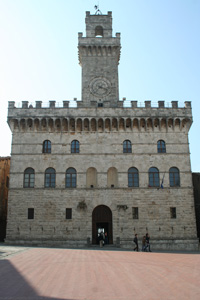
Montepulciano, Palazzo Communale
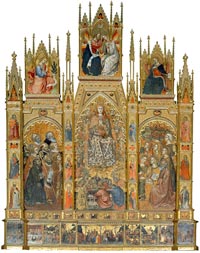 Taddeo di Bartolo, Assumption of the Virgin, Duomo Taddeo di Bartolo, Assumption of the Virgin, Duomo
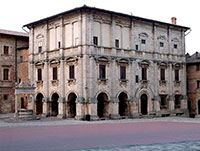
Palazzo Nobili-Tarugi
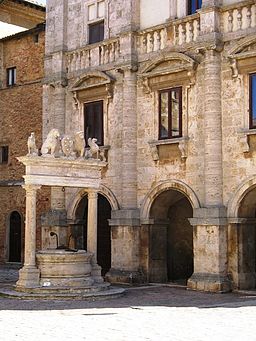
Well, Piazza Grande
|
 |
Duomo of Montepulciano, facade[6]
|
The cathedral dedicated to Santa Maria Assunta or Duomo, with its incomplete façade, rises in the highest part of the town. To reach it, you have to go up the steep hill that leads from the historic center.
The Cathedral of Santa Maria Assunta was designed by Ippolito Scalza and constructed between 1594 and 1680 on a pre-existing Medieval Pieve (Pieve di Santa Maria) to celebrate the elevation of Montepulciano to bishop's see. The Duomo houses a masterpiece from the Sienese School, a massive Assumption of the Virgin triptych painted by Taddeo di Bartolo in 1401.
Other masterpieces include Michelozzo's Aragazzi funeral monument (1427-1437) which fragments can be seen close to the main door and at the altar (two statues and the frieze with little angels); the Madonna del Pilastro by Sano di Pietro (15th century); the polychrome terracotta altar by Andrea della Robbia (1521) behind a 14th century baptismal font. Also inside are wood statues by Francesco di Valdambrino, the 16th century panel with the Redeemer by Bartolomeo Neroni (il Riccio) and a 17th century with St. Sebastian.
|
|

Assumption of the Virgin triptych painted by Taddeo di Bartolo |
Events
|
|
|
In July-August there is Cantiere Internazionale d'Arte, an arts festival created by the German composer Hans Werner Henze. In August there are two festivals: the Bruscello takes place on the 14th, 15th and 16th, when hordes of actors reenact scenes from the town's turbulent history.
For the Bravio delle Botti, on the last Sunday in August, there is a parade through the streets followed by a barrel race and a banquet to end the day.
Calici di stelle (10 August) is the main summer event in Montepulciano. The Strada del Vino Nobile offers an enogastronomic tour in the various Quarters of Montepulciano with wine tastings and a typical dinner under the guidance of expert Sommeliers and never the less various entertainments and music shows.
Events in Montepulciano | Il Bruscello and Il Bravio delle botti
The Italian scenes for the cult film New Moon, were filmed in Montepulciano. The release of the film, by the director Chris Weitz is forecast for the 20th November, 2009.
Pietra Detassis editor-in-chief of the monthly 'Ciak' has confirmed this on her blog:
"'At lunch in Los Angeles with one of the producers of Summit Entertainment, responsible for 'Twilight' and now 'New Moon', the sequel of the saga taken from the books by Stephenie Meyer, explodes this bombshell: Despite the announcements, anticipation and generous offers from every kind of Mayor and Municipality, the vampiresque sequel will not be shot in the romantic places of Volterra, but in Montepulciano where the troupe has found 'the most beautiful place to film'...
In the cast will be present the actors of the first film 'Twilight' Kristen Stewart, Robert Pattinson, Jacob Black and the new entry Dakota Fanning.
Vino Nobile di Montepulciano
Montepulciano's history has always been closely linked to the fame of its vines and wine. Wine has been a part of Montepulciano's history since its earliest origins, as is demonstrated by the kylix (wine cup) with red figures made in Chiusi and discovered in 1868, along with numerous bronze objects, in an Etruscan tomb near the Tuscan town. Francesco Redi, renowned doctor and naturalist and a poet, thoroughly praised the wine in his dithyrambic ode Bacchus in Tuscany (1685) in which Bacchus and Ariadne extol the finest Tuscan wines. The poem ends: Montepulciano is the king of all wines!
The production zone for "Vino Nobile di Montepulciano" lies within the municipal area of Montepulciano except for the lower part of Val di Chiana.
Wines in Tuscany | Vino Nobile di Montepulciano | Member companies of the DOCG Vino Nobile di Montepulciano
|
|
|
|
| |
|
|
Built of honey - and cream - colored travertine, the Sanctuary of the Madonna di San Biagio is Sangallo's masterpiece. It is a typical 16th century Tuscan edifice, designed by Antonio da Sangallo the Younger on a pre-existing Pieve, between 1518 and 1545.It has a circular (central) plan with a large dome over a terrace and a squared tambour. The exterior, with two bell towers, is built in white travertine.
|
|
Montepulciano, the Sanctuary of the Madonna di San Biagio, on the road to Chianciano, just outside the city
. |
Considered to be Antonio da Sangallo the Elder's masterpiece and one of the most significant structures of the Renaissance, San Biagio occupied the acclaimed Renaissance architect from 1518 until his death in 1534, and although it maintains a low profile among guidebook tourists, it's an absolute must-see. San Biago is a compact structure of cream and honey colored stone, expertly formed, and although it is hardly the biggest church you'll see in Italy, it gives off a sense of quiet majesty and imposing mass far beyond its actual physical size.
|
| |
San Biagio, at Montepulciano
by Yves Bonnefoy
Columns, arches, vaults: how he knew
The ways you promise what you lack;
And that your bodies, like your souls,
Always slip from our grasping hands.
Space is such a lure . . . Swift to disappoint,
As they raise and topple clouds, the sky's
Architects still offer more than ours,
Who only build a scaffolding of dreams.
He dreamed, all the same; but on that day,
He gave a better use to beauty's shapes:
He understood that form means to die.
And this, his final work, is a coin
With both sides bare. He made in stone,
Of this great room, the arrow and the bow.
[Translated by Hoyt Rogers]
|
|
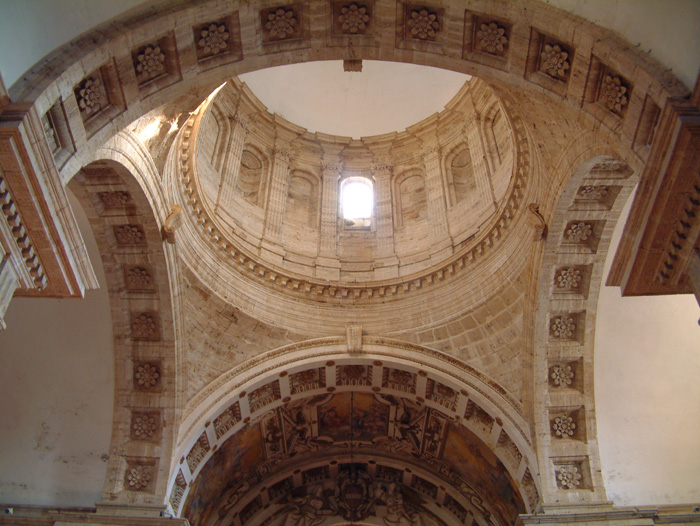 |
San Biagio, interior
|

|
|
|
[1] History | According to legend, it was founded by the Etruscan King Lars Porsena of Chiusi; recent findings prove that a settlement was already in existence in the 4th-3rd centuries BC. In Roman times it was the seat of a garrison guarding the main roads of the area.
After the fall of the Western Roman Empire, it developed as a religious center under the Lombards. In the 12th century it was repeatedly attacked by the Republic of Siena, which the Poliziani faced with the help of the Perugia and Orvieto, and sometimes Florence, communes. The 14th century was characterized by constant struggles between the local noble families, until the Del Pecora family became rulers of the town. From 1390, Montepulciano was a loyal ally (and later possession) of Florence and, until the mid-16th century, lived a period of splendour with architects such as Antonio da Sangallo the Elder, Jacopo Barozzi da Vignola, Baldassarre Peruzzi, Ippolito Scalza and others, building luxurious residences and other edifices here. In 1559, when Siena was conquered by Florence and Montepulciano lost its strategic role, its importance declined.
After the unification of Italy and the drying of the Val di Chiana, the town remained the most important agricultural centre in the area, while the industrial activities moved mostly next to Chiusi, which was nearer to the railroad being built in that period.
[2] See also: Art in Tuscany | Domenico Ghirlandaio | The Tornabuoni Chapel and Poliziano.
The colonna del Marzocco
Located in the centre of the small Piazza Savonarola, just off Via di Gracciano nel Corso, is the Colonna del Marzocco.
This column stands in Piazza Savonarola, just off Via di Gracciano nel Corso on the Northern end of Montepulciano. This tall column was erected in 1511 and was built to confirm Montepulciano's allegiance to Florence.
The Lion on the statue is the 'Marzocco', the heraldic lion that is a symbol of Florence (a similar sculpture sits outside the Palazzo Vecchio in Florence). It was put there in 1511 to replace a She-wolf which is the symbol of Siena.
|
|
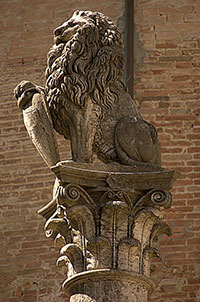
Colonna del Marzocco |

|
Un leone di Palazzo Avignonesi a Montepulcian[4]
|
| |
|
|
|
|

|
|
|
Villa La Vagnola
|
|
|
This villa was built, from 1750 onwards by the Cetona-born nobleman Sallustio Terrosi, on the occasion of his marriage to Maria Antonietta Vagnoli. The site, formerly occupied by a collection of 17th-century hovels, was completely cleared and transformed by large-scale earthworks that created a much more even piece of land to build on. The park, on the other hand, is a 15-hectare hill bordered by a wall of cypress threes, and includes a ragnaia, or hunting wood, with holm-oaks and other perennials, a garden in the area adjoining the building, olive groves and kitchen gardens. Underground is a whole system of artificial tunnels, many of them with stalactites and stalagmites, and blocks of travertine hewn from the Mt. Cetona's many caves. The park is also full of other structures created by Sallustio and his descendants, inculding an Etruscan tomb dating back to the 7th century BC, reconstructed after being brought here from its original location; a two-hundred-seat stone theatre, with hedges for the stage backdrop and wings; bird-snaring nets; and the so-called casina turca, or Turkish house, completely frescoed in the fashionable style of the day.
|
|
|
Villa La Foce, near Montepulciano, is a re-created renaissance style garden designed by Cecil Pinsent between 1927 and 1939 for Iris Origo, a writer and horticulturalist. Pinsent worked from 1927 onwards at La Foce, developing a romantic garden around a villa that had originally been a pilgrim hospice on the via Francigena. Here, his client was Iris Origo, who had grown up at the Villa Medici in Fiesole.
Villa La Foce is the main house on the property, consisting today of almost 1200 acres of farmland several farmhouses. It was originally built at the end of the 15th century as a wayside tavern, but soon became the center of an estate belonging to the great Hospital of Santa Maria della Scala in Siena. In 1924 it was purchased by Antonio and Iris Origo, and turned it into their comfortable home, from where they farmed and developed the land.[read more]
From the point of view of a nature lover the most interesting part of the district is the Oasi (Protected Natural Area) located around the banks of the lake of Montepulciano.
Gardens in Tuscany | Villa La Foce
|
|
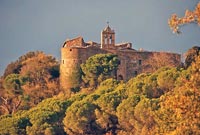 Villa La Foce, il Castello
Villa La Foce, il Castello |
Riserva naturale Lago di Montepulciano
The reserve, which is run by the LIPU, takes in a humid zone of 470 hectares of which a third is the actual lake and the rest the surface is covered by a typical swamp vegetation.
This is one of the last great swamps in Tuscany and as such generates much naturalistic interest in the migratory passing, the wintering and nesting of many species of birds, some of which are rare and threatened.
Visiting the oasis you can hike along a round track (800 mts. long) with three bird-watching huts and a number of simpler watching places. In addition, you can explore by boat the restricted area, the Canale Maestro della Chiana (the Main Channel of the Valdichiana District) and the whole lake. The Canale Maestro della Chiana flows through the Oasi, then flows into the Montepulciano lake. A great number of bird species can be seen in the lake, both migratory and nesting birds.

In addition to the short walk to the Tempio di Madonna di San Biagio, there's an enjoyable short walk (or cycle) to Sant'Albino, home of the local spa Terme di Montepulciano (Via delle Terme 46, www.termemontepulciano.it, open all year).
Longer itineraries take you along quiet dirt roads to the medieval hill town of Monticchiello and onto Pienza, and past the Tempio di Madonna di San Biagio and up to Montefollonico.
|
Walking and trekking in Tuscany | Walking in the Val d'Orcia
|
|
|
A walk through Montepulciano
|
|
|
Confined within its ancient city walls and bastions, Montepulciano is crossed by a long wide street called the Corso, the main street of Montepulciano. The Corso stretches for 11.5 kilometers from the Porta al Prato to the Piazza Grande at the top of the hill.
The
Corso starts at the Porta al Prato, taking you first to Piazza Savonarola, with its column decorated with the Marzocco (lion with shield), the symbol of Florence, which replaced the original Sienese Lupa (she wolf), during their brief period of rule. From the Church of St. Agostino we can walk up to the main square, the Piazza Grande, and from there to the Temple of San Biagio (Via di San Biagio 14), a serene and harmonious church that is considered the peak of Antonio da Sangallo’s architectural brilliance.
Walking in Tuscany | A walk through Montepulciano
|
|
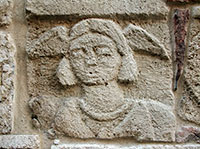
Along the Corso, Palazzo Buccelli (Via di Gracciano nel Corso 73) stands
out for its extraordinary exterior. Arange of antique sculptures were added to the
façade by Pietro Buccelli in the early 1700s, including fragments from Etruscan funerary urns and frieze plaques.
|

|
Etrurian tombstone and inscriptions at Palazzo Bucelli in Montepulciano[4]
|
Riserva Naturale Lago di Montepulciano
|
|
|
The reserve, which is run by the LIPU, takes in a humid zone of 470 hectares of which a third is the actual lake and the rest the surface is covered by a typical swamp vegetation.
This is one of the last great swamps in Tuscany and as such generates much naturalistic interest in the migratory passing, the wintering and nesting of many species of birds, some of which are rare and threatened.
Two marked trails departing from the Visitor Center take you past hides where you can view more than 130 species of birds, including nesting species such as the purple heron and little bittern, and residents like the great crested grebe, water rail, Cetti's warbler, fan-tailed warbler and sedge warbler.
Three walks (It)
LIPU Oasis Lago di Montepulciano (Loc. Tre Berte, tel. 0578-767518, www.riservenaturali.provincia.siena.it, Wed-Sun, 9 am-1 pm, 3-7 pm)
|
|
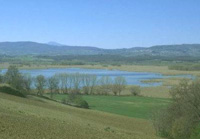 Lago di Montepulciano
Lago di Montepulciano |
From Chiusi to the Lake of Montepulciano (cycling trail)
|
|
|
You begin cycling from the Chiusi railway station, easily reaching the path’s start point. The route begins right where the embankment lies, built following the 1780 settlement between the Grand Duchy of Tuscany and the Papal State. The embankment marks the boundary between the Tuscan area of Chiana that descends towards the Arno River and the Roman Chiana area that leads towards the River Tevere. Nearby, towards the south, stands the impressive ‘Callone Pontificio’ (also named the ‘Campo alla Volta’) that used to regulate the entrance of the waters of the Chiusi lake flowing towards the River Tevere, before the embankment was built.
Having passed the hill of Chiusi, you soon reach the Torri (Towers) of Beccati Questo and Beccati Quello (or “Quest’altro”). The first one was built in 1427 by the Sienese in order to protect themselves from the expansionist aims of the inhabitants of Perugia, who immediately after, built the second tower. What is absolutely true is that even nowadays, these towers mark the boundary between Tuscany and Umbria and they both give the impression of defending their each and own lands.
The first part of the journey takes you through valuable and important naturalistic environments, cycling in the heart of the green areas around the Lake of Chiusi and, immediately following, the Lake of Montepulciano, perfect places for delightful stopovers. These lakes are the ‘memory’ of the ancient marshes. The Lake of Chiusi is also where the legendary flight of Santa Mustiola took place: pursued and imprisoned by the emperor, she succeeded in reaching the lake by making a sort of boat out of her cloak that enabled her to float across the water. The legend goes on to say that every 3rd of July, at night, you can see Santa Mustiola’s golden wake in the water.
The lakes called the ‘Chiari’ of Chiusi and Montepulciano are much-loved destinations for many, from nature enthusiasts to bird watchers. Welcome to the world of herons, ducks, little egrets and little bitterns. Along this part of the path, you enter the silent lake’s peaceful atmosphere, winding along the luxuriant, humid areas among poplars and willows. Near the Lake of Montepulciano, the point of reference for nature lovers and bird life is the LIPU (Association for the Protection of Birds) Oasis that offers its visitors huts and platforms for bird watching as well as the chance to go for a boat ride over the lake.
|
|
|
|
|
|
|
From Montepulciano to Pienza | 11 km, 3 hours (Dutch)
|
|
|
|
|
|
A gentle up & downhill walk from the magnificent town Montepulciano to the perfect place Pienza along the beautiful scenery of Toscany. The walk starts at the Piazza Grande, next to the Duomo.
Walking in Tuscany | From Montepulciano to Pienza Map
Anello Pienza - Montepulciano | 26,5 km
Walking in the spectacular panoramic scenery of Tuscany | Montepulciano - Monticchiello | 10 km
|
|

Pienza |
|
From the Madonna di San Biagio to the Madonna delle Querce
|
|
|
This route starts from the Madonna di San Biagio (near Montepulciano), one of the many places of worship that are located nearby. Considered one of the masterpieces of the Italian Renaissance, this church was designed by Antonio da Sangallo the Elder and built in travertine. Inside, one can find stuccos and Baroque frescoes. The high altar was created in 1584; it was a great marble altar with four statues of saints, carried out by Ottaviano Lazzerini. Above the altar, one can appreciate a stained glass window depicting a Madonna and Saints by Michelangelo da Cortona. The temple’s origin is linked to a miracle that happened on April 23, 1518. Two women and a shepherd passed in front of a fresco depicting Saint Francis and the Madonna and Child and they saw the eyes of the Virgin move as if she were alive.
From here, we can cross the vineyards and arrive at the Madonna della Quercia. The sanctuary of the Madonna of Querce is located outside the village’s walls, near the Medici Fortress. This place of worship and veneration for Our Lady of Sorrows, experienced a period of decline in the 1700s. Nevertheless, up to the early post-war period the well water was well-known as the ‘Font of Milk’. Animals were made to drink at the well inside the church and women drank from it to produce high-quality breast-milk and in hopes of being cured of sterility.
|
|
|
Walking from Montepulciano to Montefollonico and Monasterio Sant'Anna in Camprena | 19 km
Just across the border of the Val d’Orcia, but still within the spectacular panoramic scenery of this World Heritage site, is the walk from Montepulciano to Montefollonico and the Abbey of Sant'Anna in Camprena, a place of great charm and spirituality between Pienza and Castelmuzio.
|
|
|
Walking From Montepulciano to Montefollonico
|
|
|
On top of a high solitary hill facing Montepulciano, stands a very characteristic medieval village of Tuscany: Montefollonico. The hike from Montepulciano to Montefollonico takes about three hours. You exit Montepulciano by the old portal closest to St. Biagio church, walking down the hill toward St. Biagio. You walk just past the church on its left and then loop around the church to the right on a paved town road that becomes a paved country road.
If you follow the directionsbelow (or the description in the book Walking and Eating in Tuscany), you will have no issues.
Montepulciano - Montefollonico | 19 km
Anello Montefollonico | 6 km
Maps: Multigraphic Val d'Orcia, Kompass nr. 662 Lago trasimeno and Kompass nr. 653 Pienza-Montalcino-Monte Amiata. |
|
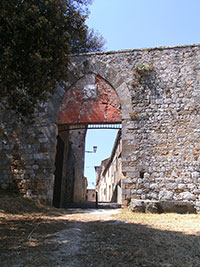
Montefollonico, Porta Triano |
| |
|
|
|
|
|
|

Podere Santa Pia, a formal cloister in the Tuscan Maremma is situated on the outskirts of Castiglioncello Bandini, and dominates one of the most beautiful settings that nature can offer: the Tuscan countryside.
Holiday homes in the Tuscan Maremma | Holiday home Podere Santa Pia
|
Restaurants in Montepulciano
Le Logge del Vignola
via delle Erbe 6 I - 53045 Montepulciano
http://www.leloggedelvignola.com/
Closing: tuesday.
La Grotta
Via di San Biagio
Opposite San Biagio church, about 1km outside the city walls. La Grotta serves pricey classic Tuscan cuisine in a sixteenth-century building with its own garden. Closed Wednesday.
www.lagrottamontepulciano.it/
La Bottega del Nobile
Via Di Gracciano Nel Coso 95, Montepulciano
www.vinonobile.eu
Ristorante Villa Nottola
SS 326 Loc. Nottola, 15, 53045 Montepulciano
www.ristorantevillanottola.com
Osteria Porta di Bacco
Via di Gracciano nel Corso
Just inside the Porta al Prato, this quiet, characterful old stone-arched place.
Closed Tuesday.
Osteria Acquacheta
Via del Teatro 22, 53045 Montepulciano
http://www.acquacheta.eu/
Piccola Trattoria Guastini
Via Lauretana Nord, 20, 53045 Valiano, Montepulciano
http://www.piccolatrattoriaguastini.it/
Caffè Poliziano
Via di Voltaia nel Corso 27.
An 1868 tearoom restored to a classic Art Nouveau design.
Restaurants in Montefollonico
|
The La Braccesca estate | Vigneto Santa Pia
This wine is produced from a 15-hectare vineyard located in Santa Pia, one of the localities most well known for the production of Vino Nobile di Montepulciano. The vineyard grows prugnolo gentile (sangiovese) grapes, which have been carefully selected over the years so as to obtain a cru which best expresses the characteristics of this area.
The La Braccesca estate covers 342 hectares (855 acres) in a territory once occupied by the estate of the Bracci counts, who gave their name to the property and, as well, their coat of arms, an arm (“braccio” in Italian) covered by armor which holds a sword.
La Braccesca is just a few miles away from Montepulciano, near the boundary with the Umbria region, and has an overall surface area of approximately 418 hectares (1040 acres) in two different appellations, Vino Nobile di Montepulciano and Cortona. Two strong identities, almost two different essences, which, together, constitute the estate.
Movies set in Tuscany
Heaven (2002), by Tom Tykwer
|
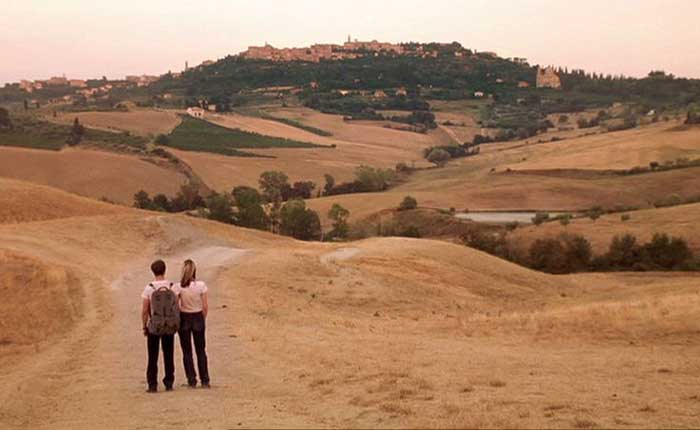 |
Philippa and Filippo reach Montepulciano
|
Heaven (2002), by Tom Tykwer, and starring Cate Blanchett and Giovanni Ribisi, was filmed in Montepulciano. The strength of the original screenplay by Krzysztof Kieslowski and Krzysztof Piesiewicz stems from its constant flow of unexpected revelations and incidents.
Tykwer’s personality runs like a watermark throughout Heaven. The subtle choice of locations governs the tone of the film, from the mysterious attic where the fugitives enjoy a charmed sanctuary, to the noble church of San Biaggio in Montepulciano where Filippo’s father bids farewell to his son.
Films set in Tuscany | Heaven (Tom Tykwer, 2002)
|
|

[1] Source: The Rough Guide to Tuscany and Umbria, pp .417-420
[2] Michelozzo was an architect and sculptor from Florence. He worked with Donatello on a number of projects including this monument to Bartolomeo Aragazzi. Throughout the Late Middle Ages and the Renaissance a major field for sculpture in Italy was the funerary monument, from simple floor slabs to splendid constructions displaying the effigy of the deceased in a magnificent niche-like setting. Donatello and Michelozzo together made such a tomb for Cardinal Baldassare Cossa in the Baptistery in Florence, and Michelozzo made one, now dismembered, for the Aragazzi family in the Tuscan hill town of Montepulciano. The picture shows the figure of Faith from the Aragazzi tomb. The vigour of Michelozzo's style and its strong classicism, place him in the second Renaissance style, but closer to Luca della Robbia than to Donatello.
In his later career Michelozzo worked mainly as an architect, and he ranks as one of the leading figures of the generation after Brunelleschi, whom he succeeded as capomaestro at Florence Cathedral (1446). His most famous building is the Palazzo Medici-Riccardi in Florence (begun 1444), often described as the first Renaissance palace. In addition to the many villas he designed for the Medici, Michelozzo designed the San Giorgio Maggiore Library in 1433 for Cosimo de' Medici. Between 1437 and 1452, he rebuilt the Convent of San Marco in Florence.
[3] Read more: www.frommers.com
[4] Photo by BobFog, released under the GNU Free Documentation License.
[5] Autore e fonte: Roberto Fogliardi "Palazzo-avignonesi-montepulciano". Con licenza CC BY-SA 3.0 tramite Wikipedia.
[6] Photo by Alessandro Antonelli, released under the GNU Free Documentation License.
|
This article incorporates material from the Wikipedia articles Montepulciano published under the GNU Free Documentation License
|
|
|
